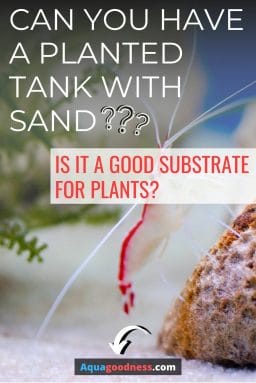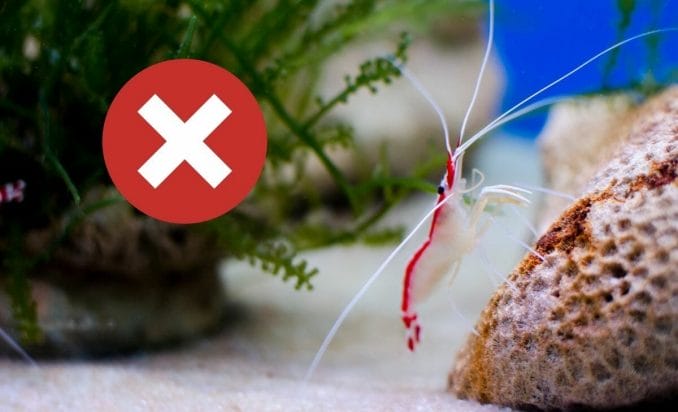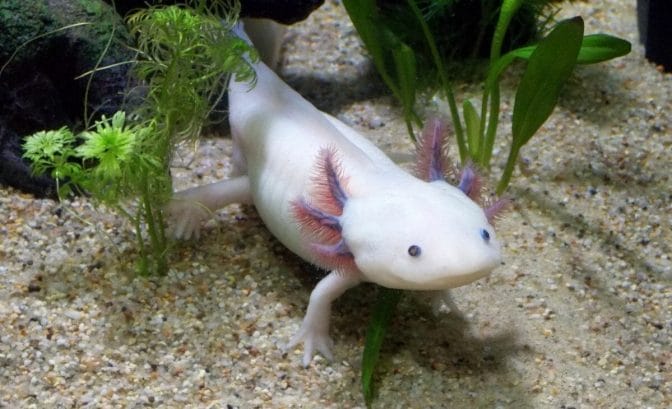No substrate looks more natural than a sand substrate in an aquarium.
But can you have a planted tank with sand?
I am going to answer this question in this article.
So let’s dive in.

You can use sand as a substrate for your planted tank. But you just have to add root tabs into the substrate to provide nutrients to the live plants as sand doesn’t provide any nutrients.
Table of Contents
Is sand a good substrate for planted tanks?
Most of the freshwater fish have sand substrate in their natural habitat.
So using sand as a substrate in your aquarium is a very good way to emulate the natural habitat of the fish.
Besides, there are a lot of benefits of using sand substrate in your aquarium.
- First of all, sand is very cheap compared to other types of substrates.
- When you add sand as a substrate in your tank it doesn’t alter the water chemistry of your aquarium water as other substrates do ex., nutrient-rich substrates.
- Sand is also very easy to clean compared to gravel because the uneaten food and fish poop doesn’t get trapped into the substrate. It stays on the surface of the sand so it is very easy to clean.
But is sand a good substrate for a planted tank?
A lot of people don’t consider sand ideal for planted tanks.
And they are right!
Because, the thing is, live plants require nutrients to grow. And sand doesn’t provide any nutrients to the plants.
But you can provide nutrients to the plants by adding root tabs into the sand substrate.
Root tabs are basically small tablets that contain fertilizers.
And when you add them in the substrate near the roots of the live plants, the root tabs will slowly release the nutrients into the substrate. The roots of the live plants will absorb these nutrients and grow in the tank.
8 Best Aquarium Plants for Sand Substrate
What type of sand can I use in my aquarium?

Ideally, you should use the sand which is specially designed for aquariums.
I recommend Caribsea Super Naturals Aquarium Sand. You can check it out at Amazon here.
And you should avoid any other type of sand which is not made for aquariums such as play sand.
The reason you should not use any other type of sand for example Play Sand because it fit very tightly into the aquarium. So it suffocates the roots of the live plants and they don’t spread into the substrate.
Besides, as these types of sands are very tightly packed into the aquarium, there is always a risk that it will create toxic gas pockets in the substrate.
And these gas pockets can burst at any time in your aquarium. And the gases released from these pockets are harmful to your fish. It can even cause the death of the fish in your aquarium.
Can Aquarium Plants Carry Disease?
What are the benefits of sand substrate?

There are several benefits of using sand as a substrate in your aquarium.
- First of all, sand is very cheap. You can get sand for the substrate of a 10-gallon tank for as low as about $15 – $20.
- Sand doesn’t alter the water chemistry of your aquarium water. Like other non-inert substrates which raise the pH and hardness of the water when you add them in your aquarium.
- The uneaten food and fish poop produce ammonia in your aquarium. Ammonia is very harmful to fish. A high ammonia level can even lead to the death of the fish in your aquarium. That’s why it is very important to remove the uneaten food immediately after feeding the fish in your aquarium. Also, remove the fish poop from your tank regularly. Removing debris from the aquarium can get a bit tricky if you use other types of substrates like a gravel substrate because the debris can get trapped into the substrate. But if you use sand as a substrate in your aquarium then the good part is that the uneaten food and fish poop doesn’t get trapped into the substrate. It stays on the surface of the sand substrate which you can easily remove by hovering the siphon over the sand substrate.
- A sand substrate is great to emulate the natural habitat of fish. Many freshwater fish have sand substrate in their natural habitat. So when you use sand substrate in your aquarium the fish feels like they are at home.
These are all the benefits of using a sand substrate in your aquarium.
So does this mean that sand is the perfect substrate for an aquarium?
No! Almost everything has its benefits and drawbacks and we are going to talk about the drawbacks of using sand substrate in your aquarium now.
How to Keep Aquarium Plants Alive Before Planting?
What are the drawbacks of using a sand substrate in a planted tank?

We have already talked about the benefits of using a sand substrate.
However, there are also some drawbacks of using sand substrate in a planted aquarium.
I will also tell you the solution for every drawback of using a sand substrate.
1. Toxic gas pockets
The most lethal drawback of using cheap sand like Play Sand for the substrate of your aquarium is toxic air pockets can build up in such substrates.
This is because when you use cheap sand like play sand as a substrate for your aquarium it gets very tightly packed in your aquarium which creates pockets.
In these pockets, anoxic bacteria build-up which releases hydrogen sulfide gas.
Now, this gas is very harmful to the fish in your aquarium.
And when the toxic gas pockets blow up the gas gets released into the water of your aquarium which can even cause the death of the fish in your tank.
2. No nutrients
Live aquarium plants require nutrients for their growth. And sand doesn’t provide any nutrients to the live aquarium plants.
Besides, sand has a low Cation Exchange Capacity (CEC).
CEC is basically the substrate’s ability to absorb and hold the nutrients.
This is important because if the substrate has a low cation exchange capacity like in the case of sand, it will not absorb and hold the nutrients to provide to the live aquarium plants.
The fix for this problem is root tabs!
Root tabs are nothing but small tablets of fertilizers.
You have to insert the root tabs near the roots of your live aquarium plants.
The root tabs will slowly release fertilizers into the substrate. And this way, plants will get and absorb the nutrients from the substrate.
Besides, providing fertilizers to the plants using root tabs is very convenient. Because you just have to insert the root tabs after every about 2 months. And it will slowly release the fertilizers for the next two months.
3. Algae growth due to excess liquid fertilizers
As I mentioned earlier, sand has low cation exchange capacity so it is unable to attract or absorb and hold the nutrients.
So when you add excess liquid fertilizer in your are planted tank, the liquid fertilizer will not get absorbed by the sand substrate.
Now algae can take advantage of this excess liquid fertilizer and grow in your aquarium.
So what should you do if you noticed algae growth in a planted tank that has sand substrate?
There could several reasons for algae growth but if you think it is due to excess liquid fertilizers then you should cut back on the liquid fertilizers and clean up the algae from your tank.
And you will not notice algae growth again in your aquarium.
6 Best Aquarium Plants to Prevent Algae
4. Roots of the live aquarium plants suffocate
When you use cheap sand as a substrate for your aquarium like play sand it gets packed very tightly in your aquarium.
And when you plant the live aquarium plant in the sand substrate, the roots suffocate because they don’t have the space to spread out in the sand substrate.
Now this problem can be easily solved by using a good quality sand substrate i.e. the sand specifically designed for aquariums like Caribsea Super Naturals Aquarium Sand (Check it out at Amazon here) instead of using cheap sand substrate like play sand.
5. Sand getting into the inlet of aquarium filter
Another problem many aquarists face when they use sand substrate in their tank is the sand the inlet pipe of the aquarium water sucks up the sand.
Now this problem can be easily fixed by adding a filter sponge before the inlet of the aquarium filter.
Also, you should keep the inlet at least two to three inches above the substrate.
Are Aquarium Plant Fertilizers Safe For Fish?
How to plant the live aquarium plants in a sand substrate?
You can easily plant the live aquarium plants in your sand substrate by burying the roots of the plants into the substrate.
Now if you have some freshwater fish like Oscar fish which like to dig the substrate then they will uproot the plants that you’ve planted in the sand.
The solution to fix this problem is to get a bottle lid and split it and make a cross-cut on it.
Now insert the roots of the live plants through the lid. And bury the lid into the substrate.
Now your fish will not be able to uproot the plants.
If I’ve not explained the trick well then you should watch this video for clarification.
If you are fuzzy about this trick then watch the video below.
Recommended sand substrate for planted aquarium
- Cream color sand– Caribsea Super Naturals Aquarium Sand (Check reviews and latest price at Amazon here)
- Black color sand– Flourite Black Sand (Check reviews and latest price at Amazon here)
Recommended root tabs for planted aquarium
- Seachem Flourish Tabs– Check reviews and latest price at Amazon here
- ThriveCaps– Check reviews and latest price at Amazon here
FAQ

Is sand or gravel better for a planted aquarium?
Both sand and gravel are not considered ideal for planted tanks.
This is for the reason that live aquarium plants require nutrients for their growth. And both sand and gravel don’t provide any nutrients to the live aquarium plants.
However, this doesn’t mean that you can’t have a planted tank with sand or gravel.
You just have to provide the nutrients through root tabs.
Besides, there are a few similarities between sand and gravel such as both are very cheap.
And both are inert substrates so they will not alter the water chemistry of your aquarium water.
Besides, both come in different sizes, shapes, and color variations.
However, you will see more variations in gravel compared to sand.
Some gravel has sharp edges which can damage the fish in your aquarium especially the bottom-dwelling fish and the fish with a delicate belly.
On the other hand, sand is a very soft substrate which makes it ideal for bottom-dwelling fish.
Also, the debris is very easy to clean if you have a sand substrate because it doesn’t get trapped into the substrate like in the case of gravel.
The debris just sits on the surface so you can easily remove it by hovering siphon over the surface.
Gravel also has some advantages over a sand substrate.
As gravel is very heavy, while cleaning the substrate, it doesn’t get sucked up into the siphon as sand does.
Also, because gravel has very large particles it doesn’t get into the inlet pipe of a filter or pump like sand does which can potentially damage your equipment.
Overall, both sand and gravel have some similarities and some advantages over the other.
So whether sand or gravel is good for your aquarium really depends on the setup of your aquarium. And the aesthetic look you are going after.
13 Best Aquarium Plants For Gravel Substrate
What is the best substrate for a planted tank?
The best substrate for a planted tank is the substrate that provides a lot of nutrients to the live aquarium plants to grow.
Here are some of my recommendations for nutrient-rich substrates:
- CaribSea Eco-Complete– Check reviews and latest price at Amazon here
- Fluval Plant and Shrimp Stratum– Check reviews and latest price at Amazon here
Do guppies prefer sand or gravel?
Guppies spend most of their time in the middle or top part of an aquarium.
Guppies don’t mind whether you use sand or gravel as a substrate for your aquarium.
So it is just your personal choice whether you want to use sand or gravel as a substrate for your guppy tank.
10 Best Live Plants For Guppies
How long till sand settles in an aquarium?
It can take anywhere between a couple of hours to a couple of days for sand to settle in your aquarium.
Exactly how much time it will take to settle really depends on the size of your tank. And the quality of the sand i.e. the particle size of the sand. The large particles will settle quickly compared to very fine particles.
52 Best Freshwater Aquarium Plants For Beginners
Is black sand good for aquariums?
You can use black sand as a substrate in your aquarium.
The good thing about using black sand as a substrate in your aquarium is it makes your aquarium pop. It makes the plants and fish in your aquarium pop.
6 Tips to Take Care of Live Plants in Aquarium (For Beginners)
Conclusion
Overall, you can have a beautiful planted tank with a sand substrate.
The only drawback of using sand as a substrate for your planted tank is it doesn’t provide any nutrients to the plants.
So, to provide the nutrients, you will have to insert root tabs into the sand substrate in your aquarium.
I hope you found the article helpful.
If you do, please share it
Happy aquascaping!
Related articles: